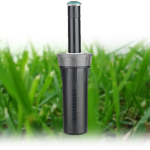A good irrigation system will reward the user for many years, making life easier, improving the condition of the garden, and adding value and beauty to your property. Installing the best system for your property requires careful consideration regarding your landscape needs, desired functionality, and design for both now and in the future. Virtually every user will expand/change their system over time.
An irrigation system consists of pipping from the water supply (i.e. mains/tank/dam), fittings (i.e. sprinklers/lawn pop ups/misters/drippers etc), and irrigation solenoid valves (called “irrigation valves” or “irrigation solenoids”) which are wired to the irrigation controller. When choosing an irrigation system, most consideration should be given to the irrigation controller.
The irrigation controller is the most important aspect of an irrigation system as it is responsible for sending commands through wires (using a low safe voltage) to the irrigation solenoid valves. These valves simply turn on/off the water supply to sprinklers, drippers and misters in an area/zone (e.g. lawn, hedges, etc).
There are many different types of irrigation controllers in the market and it is all too easy to get a controller that is hard to use, cannot expand, and is unable to perform the functions required. Unfortunately, many irrigation controllers are complicated to use and limited in their functionality. Users often end up buying a replacement controller when they realise the required functionality has not been achieved.
When choosing the right irrigation controller for your garden, you need to consider the following:
- What is the total number of zones (areas to be watered) across your landscape?
For example, you need to consider if you have covered all the lawns, hedges, pot plants, veggies, rockeries, ferneries, etc? Have you considered future changes that you will make to your garden? Can you expand your irrigation system to manage these changes? How large an area needs to be covered? Do you have enough water pressure/flow to cover a large area?
Having separate zones for irrigation is essential as it enables you to cover large areas (limits to the water pressure and flow will mean that it is not possible to water every zone all at the same time) and for plants that need different waterings (e.g. lawns need infrequent long watering and veggies/seedlings/shrubs need several short waterings during a hot day).
Unfortunately, most irrigation controllers are strictly limited in the number of zones that can be used (usually limited to 8 or 16 zones), making future expansion impossible to achieve beyond this limit. The main reason for these limitations is associated with the traditional irrigation cables that are used. These cables are made up of a fixed number of thin coloured wires which connect to solenoid valves. Once all the wires are used for connections, then no more valves/zones can be added to the controller. With these traditional systems, if you need to add additional valves/zones in the future, this can only be achieved by purchasing another controller and/or re-digging to install more irrigation cable! This can be an expensive process!
Only more advanced systems, such as the Easy Irrigation Control System, are capable of controlling dozens of zones and offering practically unlimited expansion opportunities. These systems can achieve this by using “powerline” technology, whereby a single robust cable can be used to control almost an unlimited number of solenoid valves. These systems work by attaching “decoders” along the cable which in turn attach to and control the solenoid valves. Whilst these systems can be initially more expensive, they have superior control capabilities and are much simpler and cheaper to expand in the future.
- Are all the zones independently controllable?
Can the zones be turned on/off independently? Can the controller have more than one zone on at the same time? Unfortunately, many controllers cannot do this. If there is adequate water supply, turning on more than one zone at a time will result in time savings for the overall watering.
- Can the system be controlled off site?
Can the controller be operated remotely by a smartphone, laptop, PC etc? Is a special app required? Will the system work if the internet connection is down? It is important to be aware that remote control is not possible for controllers that only offer only local Wi-Fi or Bluetooth. For a large property, range can be a problem as these technologies can be limited to only tens of metres or less (i.e. if buildings/obstacles are in the line of sight).
- Can the right amount of water specific to the different plant types/zones be controlled?
Most irrigation controllers can only turn on one zone at a time and have durations only settable to the minute. Consider hundreds of waterings over a year at 5 minutes versus 4 minutes and 30 seconds. The latter will result in considerable water and cost savings over time.
Advanced controllers have a “wet and wait” feature whereby the watering duration is split into smaller on/off cycles (e.g. on for 2 minutes and off for 3 minutes) to allow water to sink in without excessive wastage through runoff.
Many controllers are limited in their maximum duration – often 120 minutes which can be unsuitable for a slow dripper zone which might require a couple of hours of very slow irrigation.
Precise duration control is important as it ensures optimum water usage (no over or under watering), cost savings and ensuring maximum plant care.
- Is the scheduling simple, flexible and powerful?
Most controllers are strictly limited in the number of schedules per day and in total. This can be a real problem in hot weather where many scheduled waterings for zones may be required. Can a single “on” be easily stopped (perhaps because of rain) without having to re-enter the entire schedule? Clumsy scheduling causes users to not schedule properly and just settle for over or under watering.
Only more advanced irrigation control systems, such as the Easy Irrigation Control System, enable a user to schedule as many waterings per day as required and set schedules using every nth day, days of the week and set calendar days. These systems also enable you simply omit days as required (i.e. when it is raining) without affecting future schedules.
- Can the system utilise more than one water source if needed?
Mains water supply and/or rain tank(s), and/or dam(s)?
- Can the system use a rain sensor (often required by local regulations)?
- Are other devices (e.g. lights, fans, pool/spa pumps, water tank pumps, etc) able to be attached to the control system?
Almost no controllers can do this with the notable exception of the Easy Irrigation Control System.
- Do you want gimmicks?
Some more recent systems have some gimmicky control options. For example, some try (mostly unsuccessfully) to forecast the weather and adjust the watering schedules. If rain is forecast is it going to be enough, will it even occur? Preventing a watering due to forecasted rain that does not occur, may result in plant stress or even loss of delicate plants (e.g. seedlings). Rain can be very local, so it is much better for a human judgement to eliminate a watering or reduce its duration if/when required.
- Is the system easy to use?
Most are not!! Many conventional irrigation controllers often have confusing knobs, dials and push buttons and can only be operated on site by one user at a time. Zones are also usually numbered (i.e. 1,2,3 etc). This can be confusing as the user must know that zone 2, for example, turns on the sprinklers in the lawn. As a result of the way these systems work, many people do not know how to use their systems and often stop using them.
More advanced controllers, such as the Easy Irrigation Control System, have screen-based control functions allowing the user to enter descriptive text names for the zones (e.g. “front lawn”, “garden lights” “greenhouse”, “pool pump” etc). These systems can also be controlled onsite or remotely with most web connected devices (i.e. smartphone, PC, tablet), enabling users to have unlimited control over their system.
It is important to take these aspects into consideration when choosing a system. Only after knowing these details can you make an informed decision, save money, and prevent frustration by investing in a system that meets your irrigation needs both for now and in the future. Remember that (especially for a larger installations) the controller cost is only a small part of the overall system cost.
Please see our system comparison table for further assistance: https://easyirrigation.com.au/the-easy-irrigation-system/comparison-of-systems/
You can also contact us on:
Website: www.easyirrigation.com.au
Email: info@easyirrigation.com.au




